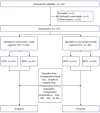Clinical efficacy and quality of life in elderly patients with lumbar degenerative disease treated with TLIF combined with unilateral pedicle screw fixation: a randomized controlled study
- PMID: 40287721
- PMCID: PMC12032780
- DOI: 10.1186/s13018-025-05821-0
Clinical efficacy and quality of life in elderly patients with lumbar degenerative disease treated with TLIF combined with unilateral pedicle screw fixation: a randomized controlled study
Abstract
Objective: To conduct a comparative analysis of the clinical efficacy and quality of life in elderly patients with lumbar degenerative disease (LDD) treated with TLIF (transforaminal lumbar interbody fusion) combined with either unilateral pedicle screw fixation (UPSF) or bilateral pedicle screw fixation (BPSF).
Methods: A total of 112 patients with single- or double-segment lumbar degenerative disease were divided into two groups. In the unilateral fixation cohort, 32 single-segment patients and 22 double-segment patients underwent TLIF combined with UPSF, whereas in the bilateral fixation cohort, 34 single-segment patients and 24 double-segment patients underwent TLIF combined with BPSF. Data on operative time, intraoperative blood loss, time to postoperative ambulation, length of hospital stay, and perioperative complications were collected and analysed. Pain and functional status were preoperatively evaluated, in addition to being postoperatively evaluated at 1, 6, and 12 months, using the visual analogue scale (VAS), Oswestry Disability Index (ODI), Japanese Orthopaedic Association (JOA) score, and Short Form-36 (SF-36) health survey questionnaire. Imaging follow-up was conducted for 1 year; at the final follow-up, the fusion rate was determined using the Bridwell fusion grading system, and clinical outcomes were assessed by using the modified MacNab criteria.
Results: All of the follow-up patients successfully completed the surgeries. There were no significant differences observed in average postoperative ambulation time or hospital stay between the UPSF and BPSF groups for either single- or double-segment patients. However, the UPSF group exhibited less average blood loss and a shorter surgery time (P < 0.05). At 12 months after surgery, there were no statistically significant differences observed in the VAS, ODI, or JOA scores between the UPSF and BPSF groups, although both scores were significantly improved compared with the preoperative scores. There were fewer perioperative complications observed in the UPSF group than in the BPSF group for both single-segment (P = 0.040) and double-segment (P = 0.009) patients. In terms of quality of life, the UPSF group exhibited better long-term physical and mental health outcomes compared with the BPSF group (single-segment PCS: preoperative, P = 0.694; 1 month, P = 0.310; 6 months, P = 0.022; 12 months, P = 0.020; MCS: preoperative, P = 0.849; 1 month, P = 0.655; 6 months, P = 0.022; 12 months, P < 0.001; double-segment PCS: preoperative, p = 0.890; 1 month, P = 0.374; 6 months, P = 0.022; 12 months, P = 0.023; MCS: preoperative, P = 0.447; 1 month, P = 0.419; 6 months, P = 0.023; 12 months, P < 0.001). At the final follow-up, there were no significant differences observed in fusion rates between the groups according to the Bridwell fusion grading system (P > 0.05), with both groups achieving satisfactory fusion rates. The modified MacNab criteria revealed that excellent and good results in each group were > 90%, with no significant differences being observed between the groups (P > 0.05).
Conclusions: For the treatment of LDD in elderly patients, both TLIF combined with UPSF and TLIF combined with BPSF can achieve favourable outcomes. However, UPSF demonstrates advantages compared with BPSF, including a shorter surgery time, reduced intraoperative blood loss, and greater postoperative quality of life.
Keywords: Bilateral pedicle screw fixation; Clinical efficacy; Elderly; Lumbar degenerative diseases; Quality of life; TLIF; Unilateral pedicle screw fixation.
© 2025. The Author(s).
Conflict of interest statement
Declarations. Ethics approval and consent to participate: This study was performed in line with the principles of the Declaration of Helsinki. The methodology and ethics were reviewed and approved of by the institutional review board of Zunyi Medical University. written informed consent was obtained from all the participants prior to the enrollment of this study. Consent for publication: Written informed consent for publication was obtained from the participant. Competing interests: The authors declare no competing interests.
Figures










Similar articles
-
Unilateral versus Bilateral Pedicle Screw Fixation Combined with Transforaminal Lumbar Interbody Fusion for the Treatment of Low Lumbar Degenerative Disc Diseases: Analysis of Clinical and Radiographic Results.World Neurosurg. 2018 Jul;115:e516-e522. doi: 10.1016/j.wneu.2018.04.085. Epub 2018 Apr 25. World Neurosurg. 2018. PMID: 29702308
-
Unilateral versus bilateral pedicle screw fixation with transforaminal lumbar interbody fusion for treatment of lumbar foraminal stenosis.Spine J. 2022 Oct;22(10):1687-1693. doi: 10.1016/j.spinee.2022.05.011. Epub 2022 Jun 7. Spine J. 2022. PMID: 35688328 Clinical Trial.
-
Is unilateral pedicle screw fixation as effective as bilateral pedicle screw fixation in transforaminal lumbar interbody fusion: a meta-analysis of randomized controlled trials.Eur Spine J. 2023 Feb;32(2):700-711. doi: 10.1007/s00586-022-07524-0. Epub 2023 Jan 4. Eur Spine J. 2023. PMID: 36598572
-
Minimally Invasive Unilateral Pedicle Combined With Contralateral Translaminar Facet Joint Screw Fixation for Single-Segment Lumbar Degenerative Disease: A 10-Year Follow-Up Study.Spine (Phila Pa 1976). 2025 Jul 15;50(14):990-997. doi: 10.1097/BRS.0000000000005224. Epub 2024 Nov 26. Spine (Phila Pa 1976). 2025. PMID: 39588666 Free PMC article.
-
Unilateral versus bilateral pedicle screw fixation in minimally invasive transforaminal lumbar interbody fusion: a systematic review and meta-analysis of randomized controlled trials.Arch Orthop Trauma Surg. 2025 Feb 1;145(1):148. doi: 10.1007/s00402-024-05749-w. Arch Orthop Trauma Surg. 2025. PMID: 39891723
References
-
- Kim HS, Wu PH, Jang IT, Lumbar degenerative disease part 1. Anatomy and pathophysiology of intervertebral discogenic pain and radiofrequency ablation of basivertebral and sinuvertebral nerve treatment for chronic discogenic back pain: A prospective case series and review of Literature. Int J Mol Sci. 2020;21(4). - PMC - PubMed
-
- Lee N, Kim KN, Yi S et al. Comparison of outcomes of anterior, posterior, and transforaminal lumbar interbody fusion surgery at a single lumbar level with degenerative spinal disease. World Neurosurg. 2017;101:216–226. - PubMed
Publication types
MeSH terms
Grants and funding
LinkOut - more resources
Full Text Sources

